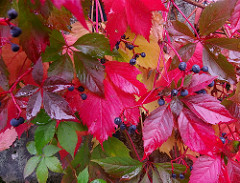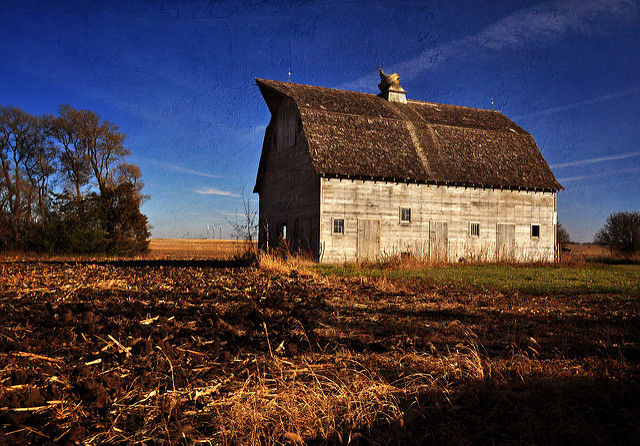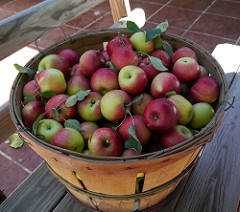The autumnal equinox marks the debut of the autumn (or fall, if you prefer) season. This astronomical event occurs quietly and without much fanfare in the sky (unlike the total solar eclipse back in August!). But at this moment, the “solar terminator” (the ring circling the earth, where day meets night), is perpendicular to the planet as it crosses the equator, thus illuminating the northern and southern hemispheres in equal amounts. In other words, on the equinox, the day and night periods are of roughly equal duration (12 hours). After the equinox, daylight hours in the northern hemisphere continue to decrease until the winter solstice — the shortest day and longest night of the year, after which the days begin to lengthen once again.
This year the equinox is on Friday, September 22 at 3:02 PM, Central Time. But even in the ebbing summer heat of early September, portends of autumn’s pending entrance are evident. We see the sun set noticeably earlier and find spent garden plants to uproot and pitch in the compost heap. Black walnuts fall with a thud, littering the ground and perfuming the air with their acrid, peppery aroma. And if you feed hummingbirds, you see them fattening up (like little Vienna sausages!) with frequent trips to the nectar dispenser, in preparation for their arduous, their non-stop flight across the Gulf of Mexico, to winter quarters.
The changing position of the sun drives the autumn transformations we experience here on Earth. As this season conjures many associations, you can focus on and relish those that bring you enjoyment — apple and pumpkin picking, football matches, hunting wild game, bird migrations, harvest celebrations, food preservation and Halloween, to name a few.
 The most spectacular association of autumn is the showy change of colors in deciduous tree leaves. I love to sit on my couch on a cool, rainy autumn day, cup of hot tea in hand, while I stare dreamily out the living room window and watch golden yellow maple leaves showering down. That, and a few rides on the KT trail, seeing the trees extravagantly adorned, makes the utmost of autumn for me. Cycling in the midst of the wind-swirling leaves creates an alternate reality, where I sense I’m under water, and I’m thrilled to be transported to this new dimension.
The most spectacular association of autumn is the showy change of colors in deciduous tree leaves. I love to sit on my couch on a cool, rainy autumn day, cup of hot tea in hand, while I stare dreamily out the living room window and watch golden yellow maple leaves showering down. That, and a few rides on the KT trail, seeing the trees extravagantly adorned, makes the utmost of autumn for me. Cycling in the midst of the wind-swirling leaves creates an alternate reality, where I sense I’m under water, and I’m thrilled to be transported to this new dimension.
The most profound association (and often challenging for many of us) though, is the melancholy that descends and permeates our internal experience of this season. What is it about this cycle of the year that drives us to darkened moods and sad places, even while witnessing nature’s exuberant pageantry of fiery beauty? Essentially, we are mourning the losses that come with this shift, from expansive summer to contractive autumn — the falling leaves signal the end of summer abundance, the diminishing sunlight extinguishes our extended outdoor time and the killing frosts drive plants and animals (including humans!) into hibernation. In the larger scheme, summer’s death symbolizes our own death, triggering grief around our eventual and inevitable demise. I’ve spent my fair share of time trying to dupe this seasonal grief, to no avail. A different perspective on this persistence phenomenon makes it more manageable. By accepting the natural balance of growth and rest required for the whole of life to work, this period of letting go and lying fallow is much easier to embrace. In fact, this quiet time is necessary for the next burst of growth in all living things, and I’ve come to appreciate it.
I leave you here with three poems — allusions to autumn’s evocations — and wish you all the enjoyments and insights this season can offer.
September Tomatoes
By Karina Borowicz
The whiskey stink of rot has settled
in the garden, and a burst of fruit flies rises
when I touch the dying tomato plants.
Still, the claws of tiny yellow blossoms
flail in the air as I pull the vines up by the roots
and toss them in the compost.
It feels cruel. Something in me isn’t ready
to let go of summer so easily. To destroy
what I’ve carefully cultivated all these months.
Those pale flowers might still have time to fruit.
My great-grandmother sang with the girls of her village
as they pulled the flax. Songs so old
and so tied to the season that the very sound
seemed to turn the weather.
Neighbors in October
By David Baker
 All afternoon his tractor pulls a flat wagon
All afternoon his tractor pulls a flat wagon
with bales to the barn, then back to the waiting chopped field. It trails a feather of smoke. Down the block we bend with the season:
shoes to polish for a big game,
storm windows to batten or patch.
And how like a field is the whole sky now
that the maples have shed their leaves, too.
It makes us believers—stationed in groups,
leaning on rakes, looking into space. We rub blisters
over billows of leaf smoke. Or stand alone,
bagging gold for the cold days to come.
November Comes and November Goes
By Elizabeth Coatsworth
November comes and November goes,
With the last red berries
And the first white snows.
With night coming early,
And dawn coming late,
And ice in the bucket
And frost by the gate.
The fires burn
And the kettles sing,
And earth sinks to rest
Until next spring.
Image credits: Edmund Garman, Autumn Tree via Flickr (license); Kelly Garbato, Apples via Flickr (license); Anne Arnould, Just After the Rain via Flickr (license); TumblingRun, After the Harvest via Flickr (license)



